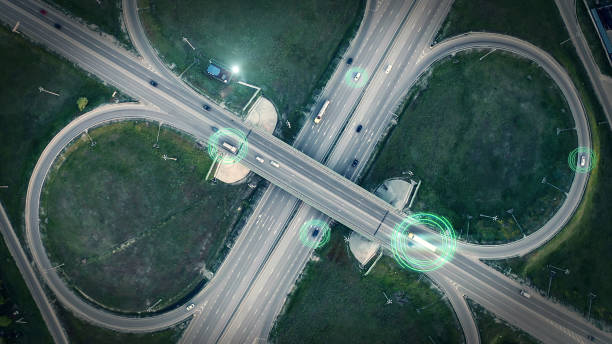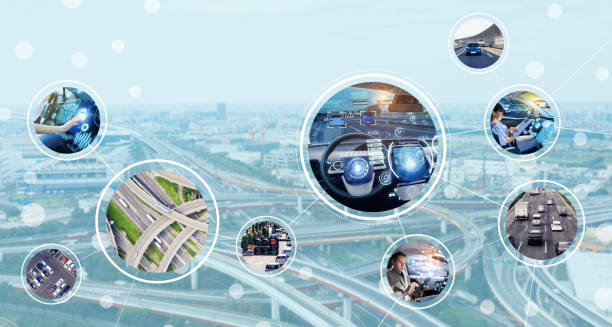Introduction
With the rapid advancements in technology, the world is witnessing a significant transformation in the transportation sector, particularly with the emergence of autonomous vehicles. These vehicles, equipped with advanced sensors and artificial intelligence, have the potential to revolutionize urban planning and infrastructure development. As cities prepare to integrate autonomous vehicles into their transportation systems, patent strategies play a pivotal role in shaping the direction of this evolving landscape. This article delves into the importance of patent strategies in the context of autonomous vehicle urban planning and infrastructure development, exploring key considerations and potential pathways for innovative solutions.

The Impact of Autonomous Vehicles on Urban Planning and Infrastructure
Autonomous vehicles are poised to redefine the way people commute within urban environments. They offer the promise of improved safety, reduced traffic congestion, and increased efficiency in transportation systems. Moreover, these vehicles can potentially lead to a transformation in urban design, as the need for parking spaces and traditional road structures might undergo a substantial shift. Consequently, the integration of autonomous vehicles into urban planning necessitates a proactive approach to patent strategies, ensuring the protection of intellectual property while fostering innovation and sustainable development.
Importance of Patent Strategies
In the realm of autonomous vehicle urban planning and infrastructure, patent strategies serve as a crucial tool for protecting intellectual property rights and fostering innovation. Here are several key reasons why patent strategies are essential in this context:
- Securing Intellectual Property Rights: Patents provide legal protection for novel inventions and technological advancements. In the domain of autonomous vehicles, securing patents for innovative software, hardware, and communication systems is critical to maintaining a competitive edge in the market.
- Encouraging Innovation: Patent strategies encourage researchers and developers to invest time and resources into creating cutting-edge solutions. By safeguarding their inventions through patents, individuals and organizations are incentivized to pursue ambitious ideas, ultimately driving the progress of autonomous vehicle technology.
- Promoting Collaboration: Patent strategies can facilitate collaborations between different entities working on similar technological challenges. By fostering an environment that promotes the sharing of patented information through licensing agreements, organizations can collectively contribute to the advancement of autonomous vehicle infrastructure.
- Attracting Investments and Funding: A robust patent portfolio can enhance the credibility of a company or research institution, making it an attractive prospect for potential investors and funding agencies. A strong patent strategy can bolster the financial stability necessary for sustained research and development initiatives.
Key Considerations in Patent Strategies for Autonomous Vehicle Urban Planning and Infrastructure
Developing a robust and effective patent strategy for autonomous vehicle urban planning and infrastructure requires careful consideration of various factors. From the technological landscape to legal frameworks and market dynamics, several key considerations play a crucial role in shaping the direction and success of patent strategies in this domain. Understanding these considerations is essential for stakeholders aiming to protect intellectual property, foster innovation, and contribute to the sustainable development of autonomous vehicle urban planning and infrastructure. Here are some key considerations to keep in mind:
1. Technological Landscape Assessment
Conduct a comprehensive assessment of the current technological landscape in the autonomous vehicle sector. Identify the latest advancements in sensor technology, communication systems, artificial intelligence, and data processing algorithms related to autonomous vehicles. This assessment provides insights into potential areas of innovation and helps in identifying opportunities for patenting novel technologies and solutions.
2. Legal and Regulatory Frameworks Analysis
Gain a deep understanding of the complex and evolving legal and regulatory frameworks governing autonomous vehicles. Analyze patent laws, intellectual property regulations, and relevant transportation policies in various jurisdictions. This analysis is crucial for ensuring compliance, understanding the scope of patent protection, and navigating the intricacies of intellectual property rights in the context of autonomous vehicle urban planning and infrastructure development.
3. Market Research and Competitive Analysis
Conduct thorough market research and competitive analysis to identify existing patent portfolios held by competitors and potential collaborators. Assess the uniqueness of proposed inventions and their commercial viability within the autonomous vehicle market. This research helps in understanding market dynamics, identifying potential partners for collaboration, and positioning patent strategies to maximize their impact and relevance in the industry.
4. Strategic Portfolio Development
Develop a strategic portfolio development plan that prioritizes patent applications based on their technical significance, commercial relevance, and potential impact on autonomous vehicle urban planning and infrastructure. Consider the short-term and long-term objectives of the patent portfolio and align the patent strategy with the overall business goals of the organization. Balancing immediate market needs with long-term innovation objectives is essential for creating a robust and sustainable patent portfolio.
5. Licensing and Collaboration Opportunities
Evaluate the potential for licensing agreements and collaborative partnerships with other stakeholders in the autonomous vehicle ecosystem. Assess opportunities for technology sharing, joint research and development initiatives, and collaborative innovation projects. By strategically engaging in licensing and collaboration opportunities, organizations can leverage their patented technologies to create mutually beneficial partnerships that foster innovation, accelerate technology adoption, and promote the development of a comprehensive autonomous vehicle infrastructure.
6. Sustainability and Environmental Impact Assessment
Assess the sustainability and environmental impact of patented technologies and solutions related to autonomous vehicle urban planning and infrastructure. Consider the potential implications of innovations on energy consumption, air quality, and overall environmental sustainability. Integrating sustainable practices and eco-friendly solutions into patent strategies not only enhances the market competitiveness of patented technologies but also contributes to the development of a greener and more sustainable urban transportation ecosystem.
7. Ethical and Societal Implications Evaluation
Evaluate the ethical and societal implications of autonomous vehicle technologies and their integration into urban planning and infrastructure. Consider the implications related to data privacy, cybersecurity, job displacement, and social equity. Addressing these ethical considerations in the patent strategy ensures that technological advancements align with societal values, regulatory standards, and public expectations, fostering a responsible and inclusive approach to autonomous vehicle development and deployment.
8. International Collaboration and Standardization
Emphasize international collaboration and standardization efforts to ensure interoperability and compatibility of autonomous vehicle technologies across different geographical regions. Engage with international standardization bodies and industry consortia to contribute to the development of global standards for autonomous vehicle communication protocols, safety regulations, and interoperable infrastructure systems. By actively participating in international collaboration and standardization initiatives, stakeholders can establish a competitive advantage while contributing to the harmonization and scalability of autonomous vehicle urban planning and infrastructure on a global scale.
By carefully considering these key factors, stakeholders can develop comprehensive and effective patent strategies that not only protect intellectual property but also contribute to the advancement, sustainability, and responsible integration of autonomous vehicles into urban planning and infrastructure development. Taking a holistic approach to patent strategy development enables organizations to navigate the complexities of the autonomous vehicle landscape and position themselves as key innovators in this rapidly evolving and transformative industry.

Emerging Trends in Patent Strategies for Autonomous Vehicle Urban Planning and Infrastructure
Emerging trends in patent strategies for autonomous vehicle urban planning and infrastructure are continuously shaping the landscape of intellectual property protection and technological innovation. As the field of autonomous vehicles evolves, several notable trends are driving the development of patent strategies, enabling stakeholders to navigate the complex dynamics of the urban transportation ecosystem effectively. These trends reflect the increasing interplay between cutting-edge technology, regulatory frameworks, and societal needs, underscoring the importance of holistic and adaptive patent strategies. Understanding these trends is crucial for organizations and researchers seeking to establish a competitive edge and contribute to the sustainable development of autonomous vehicle urban planning and infrastructure. Let’s explore some of the prominent emerging trends in patent strategies:
1. Integration of Advanced Sensor Technologies and Perception Systems
The integration of advanced sensor technologies, such as LiDAR, radar, and cameras, in autonomous vehicles is a rapidly evolving trend driving the development of patent strategies. Innovations in sensor fusion techniques and perception systems, including object recognition, localization, and environmental mapping, are crucial for enhancing the safety and reliability of autonomous vehicles within urban environments. Patent strategies focusing on novel sensor configurations, data processing algorithms, and real-time decision-making mechanisms are instrumental in securing intellectual property rights and fostering advancements in autonomous vehicle perception technologies.
2. Infrastructure-to-Vehicle Communication Solutions
The advent of infrastructure-to-vehicle communication solutions is reshaping the patent landscape, offering new opportunities for optimizing traffic flow, reducing congestion, and improving overall transportation efficiency. Patent strategies that emphasize the development of intelligent infrastructure systems, including traffic management protocols, smart traffic signals, and vehicle-to-infrastructure communication protocols, are essential for creating a seamless and interconnected urban transportation network. Innovations in communication protocols and data exchange mechanisms facilitate the integration of autonomous vehicles into existing infrastructure, paving the way for a more efficient and interconnected urban mobility ecosystem.
3. Advanced Control and Navigation Algorithms
The continuous refinement of advanced control and navigation algorithms is a significant trend influencing patent strategies in the domain of autonomous vehicle urban planning and infrastructure. Innovations in trajectory planning, path optimization, and adaptive control mechanisms are critical for ensuring the safe and efficient operation of autonomous vehicles in complex urban environments. Patent strategies that focus on the development of robust navigation algorithms, predictive control systems, and dynamic obstacle avoidance techniques are pivotal in addressing the challenges associated with real-time decision-making and ensuring the seamless integration of autonomous vehicles into existing urban transportation infrastructure.
4. Human-machine Interaction and User Experience Solutions
As autonomous vehicles become increasingly integrated into urban transportation systems, the emphasis on human-machine interaction and user experience is driving the development of patent strategies aimed at enhancing passenger safety, comfort, and convenience. Innovations in human-centric design, intuitive user interfaces, and multimodal communication systems are crucial for fostering trust and acceptance of autonomous vehicles among passengers and pedestrians. Patent strategies that prioritize the development of personalized in-vehicle experiences, proactive safety measures, and transparent communication protocols contribute to creating a user-centric autonomous transportation ecosystem that prioritizes passenger well-being and satisfaction.
5. Regulatory Compliance and Safety Assurance Mechanisms
With the evolving regulatory landscape surrounding autonomous vehicles, patent strategies emphasizing regulatory compliance and safety assurance mechanisms are gaining prominence. Innovations in safety validation protocols, risk assessment frameworks, and ethical decision-making algorithms are essential for ensuring the adherence of autonomous vehicles to stringent safety standards and ethical guidelines. Patent strategies that focus on developing comprehensive safety assurance mechanisms and regulatory compliance frameworks enable stakeholders to navigate the complex legal and ethical challenges associated with the deployment of autonomous vehicles in urban environments, fostering public trust and regulatory acceptance.
6. Data Analytics and Predictive Maintenance Solutions
The integration of data analytics and predictive maintenance solutions in autonomous vehicles is a burgeoning trend driving the development of patent strategies focused on optimizing vehicle performance and reducing operational costs. Innovations in predictive maintenance algorithms, real-time performance monitoring systems, and data-driven predictive analytics models enable proactive maintenance and efficient resource allocation, thereby enhancing the reliability and longevity of autonomous vehicles. Patent strategies that prioritize the development of data-driven maintenance solutions and predictive analytics frameworks facilitate the implementation of proactive maintenance strategies, ensuring the seamless operation of autonomous vehicles and minimizing downtime, thereby contributing to the overall sustainability and cost-effectiveness of urban transportation systems.
These emerging trends underscore the dynamic nature of patent strategies in the context of autonomous vehicle urban planning and infrastructure. By leveraging these trends, stakeholders can develop comprehensive and forward-looking patent strategies that not only protect intellectual property but also foster the continuous advancement and integration of autonomous vehicles into the fabric of modern urban transportation systems. Embracing these trends enables organizations and researchers to position themselves at the forefront of innovation, contributing to the development of sustainable, efficient, and resilient autonomous vehicle urban planning and infrastructure.

Challenges and Future Prospects
Despite the myriad opportunities presented by autonomous vehicles in urban planning and infrastructure development, several challenges persist in the realm of patent strategies. These challenges include:
- Complexity of Technological Integration: The intricate integration of various technological components within autonomous vehicles poses challenges in patenting, as innovations often involve a combination of hardware, software, and data-driven solutions. Patent strategies need to address the complexity of such integrated systems while ensuring comprehensive protection for each component.
- Regulatory Uncertainties and Ethical Concerns: The dynamic regulatory landscape surrounding autonomous vehicles gives rise to uncertainties regarding the patentability of certain technologies. Ethical concerns related to data privacy, liability, and safety further complicate the formulation of patent strategies, necessitating a nuanced approach that accounts for legal ambiguities and societal implications.
- Global Competition and Market Dynamics: Intense global competition within the autonomous vehicle market demands agile and adaptive patent strategies that can navigate diverse market dynamics. Strategic considerations related to market expansion, technological partnerships, and cross-border collaborations are crucial for establishing a strong foothold in the competitive landscape.
Looking ahead, the future prospects for patent strategies in the domain of autonomous vehicle urban planning and infrastructure remain promising. With continued advancements in technology and a growing emphasis on sustainable development, the patent landscape is poised to witness a surge in innovative solutions aimed at enhancing the efficiency, safety, and environmental sustainability of urban transportation systems. Strategic collaborations between industry players, academia, and regulatory bodies are expected to drive the formulation of comprehensive patent strategies that not only protect intellectual property but also foster a culture of innovation and responsible technological development.
Conclusion
As autonomous vehicles become an integral part of urban planning and infrastructure development, the role of patent strategies in fostering innovation and ensuring technological advancement cannot be understated. The proactive formulation of comprehensive patent strategies, coupled with a keen understanding of the evolving technological landscape and market dynamics, is essential for organizations and researchers aiming to make a substantial impact in the realm of autonomous vehicle urban planning and infrastructure. By addressing key considerations, embracing emerging trends, and overcoming existing challenges, stakeholders can pave the way for a future where autonomous vehicles contribute to the creation of sustainable, efficient, and resilient urban transportation ecosystems.

